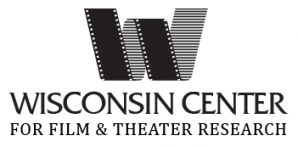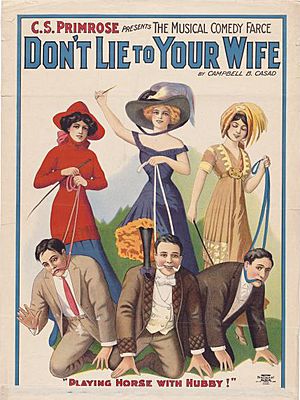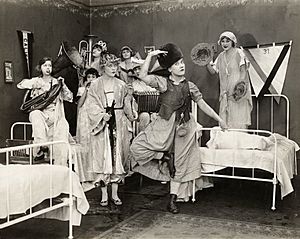Wisconsin Center for Film and Theater Research facts for kids
Quick facts for kids  |
|
| Established | 1960 |
|---|---|
| Purpose | Archive for performing arts research |
| Headquarters | 816 State Street Madison, Wisconsin 53706 |
| Website | http://wcftr.commarts.wisc.edu |
The Wisconsin Center for Film and Theater Research (WCFTR) is a super cool place! It's like a giant treasure chest filled with materials about movies, TV shows, radio, and plays. Imagine finding scripts, photos, and even old films from your favorite shows and movies!
Located in Madison, Wisconsin, the WCFTR keeps over three hundred collections. These collections come from writers, producers, actors, and directors. They include business papers, personal notes, scripts, photos, and thousands of films and videos. Researchers from all over the world visit the WCFTR to learn about how these amazing stories were made.
Contents
Discovering the Past: WCFTR's History
The WCFTR started because people wanted to save important stories. In 1955, the Wisconsin Historical Society began collecting materials about journalism and broadcasting. This showed how important these areas were in the United States.
Seeing how valuable this was, the University of Wisconsin created the Wisconsin Center for Film and Theater Research in 1960. Today, the WCFTR is part of the university's Communication Arts Department. It works together with the Wisconsin Historical Society to keep these amazing collections safe.
Exploring the Film Collection
The WCFTR has a huge collection of films from many different countries. You can find old Hollywood movies from the 1930s to the 1960s. There are also independent films from the 1960s to the 1980s. Plus, it has Soviet films and Taiwanese films.
Amazing Film Highlights
Some of the coolest films in the collection include:
- About 2,000 old 16mm films from famous studios like Warner Brothers and RKO. These are almost all the movies they released between 1931 and 1949!
- 1,500 short films called Vitaphone subjects.
- 300 classic Looney Tunes and Merrie Melodies cartoons from 1926 to 1949.
- Films by independent filmmakers like Shirley Clarke and Emile de Antonio.
Behind the Scenes: Film Papers
Along with the films, the WCFTR also has many paper records. These are often organized by the person who donated them. They include scripts, notes, and other materials that show how films were made.
- Dalton Trumbo: He was a famous scriptwriter. His papers show his work and how he was unfairly treated during a difficult time in Hollywood. You can see scripts for movies like The Brave One and Spartacus.
- Paddy Chayefsky: This writer worked for plays, movies, radio, and TV. His collection includes scripts for films like Marty, which started as a TV show.
- George Seaton: A Hollywood writer and director. His collection has scripts, notes, and letters. It covers movies like the Marx Brothers' A Night at the Opera and the classic Miracle on 34th Street.
- Walter Mirisch: His company produced many famous films and TV shows. His collection includes scripts and designs for movies like The Apartment, The Great Escape, and West Side Story.
- Kirk Douglas: A well-known actor. His papers include scripts and letters for movies he starred in or produced. These include Champion, Twenty Thousand Leagues Under the Sea, and Spartacus.
- Edith Head: An amazing costume designer who won many awards. Her collection has sketches with notes about fabrics and costs. She designed costumes for movies like Sabrina and Breakfast at Tiffany's.
- Dorothy Jeakins: Another award-winning costume designer. Her collection includes sketches and photos for films like The Sound of Music and Oliver.
Watching the Small Screen: Television Collections
The WCFTR has a huge collection of TV shows. It includes 3,500 shows from Ziv Television Programs. Ziv was a very successful company that made action and adventure shows from 1948 to 1962.
The Ziv collection has copies of every episode of shows like The Cisco Kid, Boston Blackie, Highway Patrol, and Sea Hunt. You can also find scripts and other materials for these shows.
TV Pioneers and Their Stories
The WCFTR also has collections from important people who helped create television. These include writers and producers like Rod Serling and Paddy Chayefsky.
- Ed Sullivan: He hosted the very popular Ed Sullivan Show for many years (1948-1971). His collection has scripts, production files, and even films of some full shows.
- Rod Serling: This writer and producer created The Twilight Zone. His collection has scripts, notes, and letters from his career in radio, TV, and film.
- Nat Hiken: He wrote and produced shows like The Phil Silvers Show (Sergeant Bilko) and Car 54, Where Are You?. His collection includes films of many episodes.
- Irna Phillips: She created and wrote many famous soap operas. Her collection has notes, scripts, and letters for shows like Another World and Guiding Light.
On Stage: Theater Collections
The WCFTR also has many collections about theater. These come from actors like Alfred Lunt and Lynn Fontanne. They also include playwrights (people who write plays) like Langston Hughes and Stephen Sondheim.
You can also find collections from people who design costumes, sets, and lighting for plays. The Center even has papers from the Playwrights' Company, a group that produced plays. These collections show what it was like to create Broadway shows in the 1940s, 1950s, and 1960s.
Listening In: Radio Collections
While the WCFTR focuses mostly on film and TV, it also has some interesting radio materials. Many writers, producers, and actors worked in radio before moving to TV or film.
So, the WCFTR has collections that include radio scripts from the 1940s, 1950s, and 1960s. You can find scripts for classic radio shows like The Adventures of Superman, The Shadow, and Suspense.
Seeing the Story: Photos and Promotional Materials
The WCFTR has millions of photos, posters, and scrapbooks. These help show how movies, TV shows, and plays were made and shared with the public.
- Film Title Collection: This has promotional pictures from over 40,000 movies. It covers films from the 1890s to today. You can see how studios like Warner Brothers and MGM promoted their movies.
- Television Title Collection: This collection has photos and items from over 1,700 American TV shows. It's especially good for shows from the late 1940s to the early 1960s.
- Theater Title Collection: This shows the history of American theater from the 1860s until now. It covers more than 2,888 plays, from local shows to big Broadway productions.
- Name Collection: This has photos and information about over 14,000 actors, producers, and directors from movies, TV, and theater.
You can even see some of these photos online! The Wisconsin Historical Society website has pictures of Broadway shows and silent films. They also have colorful posters for old touring plays, like the one for "Don't Lie to Your Wife."




